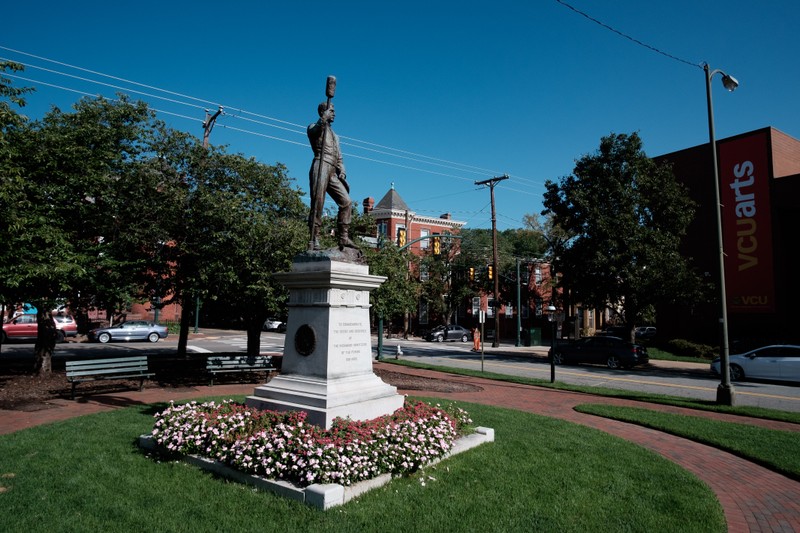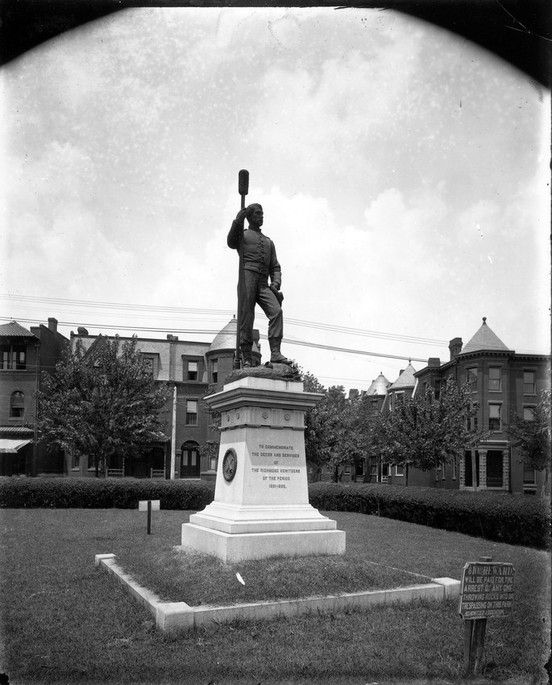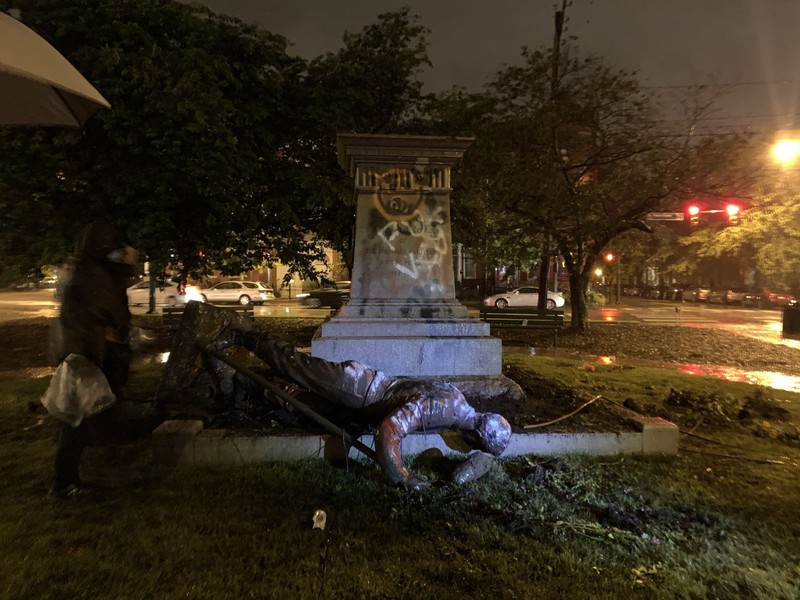Richmond Howitzers Monument
Introduction
Text-to-speech Audio
Images
The Richmond Howitzers Monument, near the VCU campus

The Howitzers Monument circa 1900

The toppled Howitzers Monument, June 2020

Backstory and Context
Text-to-speech Audio
Founded in November 1859, the Richmond Howitzers quickly emerged as an elite Richmond militia artillery company, its members drawn from prominent local families. Prior to the Civil War, the Howitzers provided security during John Brown’s trial in Charles Town. The Howitzers expanded to three companies in 1860. During the Civil War, all three companies were absorbed into Confederate military units and served the major campaigns in the Eastern Theater before surrendering during the Appomattox Campaign. In 1871, the Richmond Howitzers were resurrected as a single militia company, and they were eventually incorporated into the Virginia National Guard. Today, they Richmond Howitzer designation is retained by Battery A, 111th Field Artillery Regiment, Virginia National Guard.
In the 1890s, a movement began to establish a monument to the Howitzers. The statue was designed by William L. Sheppard, a Civil War veteran of the Richmond Howitzers. After the Civil War, Sheppard devoted his time to painting watercolor scenes that depicted everyday scenes of the life of Confederate soldiers. Eventually, he became a well-known artist and crafted several other Confederate monuments.
The monument itself depicts a bronze artilleryman standing erect in the “number one” position at the front of the gun. The "number" refers to the specific functions assigned to a soldier when shooting the enemy, and "number ones" were to ram the cartridge into the barrel of the cannon and to sponge the barrel down after the piece of artillery had been fired in order to put out any sparks before the next round was fired. The bronze sculpture sits atop a granite base at the corner of Park Avenue and Harrison Street. On the south side of the base, we can see the emblem of the Richmond Howitzers on bronze. The Latin expression adopted by the regiment reads “Cita Mors Aut Victoria Laeta”, which translates as “A Quick Death or A Sweet Victory”. On the north side we can see the emblem of the Confederacy on bronze.
The monument’s dedication occurred on December 13, 1892. Like many Confederate monument dedications, it proved a major civic affair. Many citizens, Confederate veterans, veterans of the Howitzers, and contemporary military companies were on hand for the pageantry, which featured a host of speakers, an official unveiling of the statue, and a banquet for Howitzer members. Mr. Leigh Robinson, a Howitzer veteran himself, gave the keynote speech. His address touched on many of the tenets central to Lost Cause ideology. He praised the bravery of Confederate soldier, denied that slavery was the root cause of the Civil War (instead portraying it as a struggle over constitutional liberty), and portrayed the Reconstruction era (in which Blacks had political power) as an era of coercion. He also portrayed slavery as a just institution on the grounds of white supremacy: “Slavery in the South, unlike Oriental bondage, Roman servitude, and feudal villainage, was not the subjection of equals, differing only in opportunity, but the subordination of one extreme of humanity to the other; of the most abject to the most enlightened. The real inequality of the races had made subordination prescriptive.” His speech was met with great applause, and the monument unveiled to an approving crowd as Confederate flags “floated against the winter sky.”[1]
The monument was acquired by Virginia Commonwealth University in 1989 and sat near campus. Students at VCU jokingly referred to the statue as the "Q-Tip Man" and often decorated it with a scarf and hat.
In recent years, the Richmond Howitzer Monument, like other Confederate statues, came under closer scrutiny. In the wake of the violent, white-supremacist Unite the Right rally in Charlottesville in 2017, VCU conducted in audit of Confederate iconography on campus, but the Howitzer Monument drew relatively little attention. VCU needed city approval to relocate or remove the monument.
In June 2020, following the death of Black man George Floyd and nationwide protests against systemic racism, many Confederate monuments became rallying points for Black Lives Matter protests. On the evening of June 17, 2020, protestors pulled down the Richmond Howitzers statue; it was the fourth such statue to be toppled in the span of a few days (including Confederate monuments to General Williams Carter Wickham and Jefferson Davis). Richmond Mayor Levar Stoney ordered other Confederate monuments in the city removed, and it is unlikely the Richmond Howitzer statue will be returned. Today, only the granite pedestal remains.
Sources
1. "Dropped the Veil. The Howitzer Memorial Dedicated with Impressive Ceremonies." December 14, 1892. Richmond Dispatch. Digitized via Chronicling America. Accessed November 13, 2020. https://chroniclingamerica.loc.gov/lccn/sn85038614/1892-12-14/ed-1/seq-1/
2. Arthur M. Bergeron, Jr. "The Richmond Howitzers." September 22, 2014. Encyclopedia Virginia. Web. Accessed November 13, 2020. https://www.encyclopediavirginia.org/Richmond_Howitzers#start_entry
3. "Richmond Howitzers Monument." Encyclopedia Virginia. Web. Accessed November 13, 2020. https://www.encyclopediavirginia.org/media_player?mets_filename=evm00002060mets.xml
4. Hannah Eason, Eduardo Acevedo, and Andrew Ringle. "Confederate Howitzer monument torn down on VCU campus." June 17, 2020. Commonwealth Times. Web. Accessed November 13, 2020. https://commonwealthtimes.org/2020/06/17/confederate-howitzer-monument-torn-down-on-vcu-campus/
5. Ned Oliver. "Like UNC, VCU has its own Confederate memorial dedicated with explicitly white supremacist speech." August 23, 2018. Virginia Mercury. Web. Accessed November 13, 2020. https://www.virginiamercury.com/2018/08/23/like-unc-vcu-has-its-own-confederate-memorial-dedicated-with-explicitly-white-supremacist-speech/
Virginia Mercury: https://www.virginiamercury.com/2018/08/23/like-unc-vcu-has-its-own-confederate-memorial-dedicated-with-explicitly-white-supremacist-speech/
The Valentine, via Encyclopedia of Virginia: https://www.encyclopediavirginia.org/media_player?mets_filename=evm00002060mets.xml
Andrew Ringle, Commonwealth Times: https://commonwealthtimes.org/2020/06/17/confederate-howitzer-monument-torn-down-on-vcu-campus/
